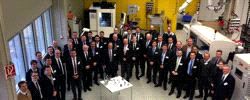Inkjet & Digital Printing
Additive Manufacturing To Change Industrial Value Chain Completely

Monday 02. March 2015 - To Ulli Klenk, chairman of the board of the Additive Manufacturing Association within VDMA, the goal is clear: "We need to get out of laboratories and into industrial production!" Within additive manufacturing, the German industry has attained a good starting position, which it will now need to use for industrialization of the procedures, so Klenk said at the general assembly of the Association taking place in the Hamburg based LZN Laser Zentrum Nord GmbH.
Prof. Claus Emmelmann, the LZN’s general manager, emphasized the enormous importance of additive manufacturing: “It will completely change industrial added value. This opens up opportunities but also risks for those too late in attending to this game-changing technology.” He advised companies not to complain about still-high costs and not to wait for cost structures to adapt to conventional manufacturing procedures. Instead, he advised companies to familiarize themselves early on with the special features of the new engineering and production method in order to capitalize on their opportunities. As part of those, he mentioned bionic transformation of products, integration of new functions in components, and also the option of producing spare parts additively on demand instead of storing them. Those already engaging themselves in this technology will profit from the machines’ expected increase in productivity and their own learning curve; they will also create ideal conditions for the process world of Industry 4.0.
The Additive Manufacturing Association is Growing
Since their constitutive session in the spring of 2014, the Association initiated by the VDMA has grown to include 64 members. Thus, according to Rainer Gebhardt, the VDMA’s responsible project manager, membership numbers have about doubled. “We created this open and international-minded Association in order to further this young technology through direct interaction between machine manufacturers, suppliers, users, contractors, and research institutes,” he explained. So far, 56 companies of the said sectors and 8 research institutes have become affiliated. It is their joint goal to further additive technology and process chains towards industrial production, and to harmonize norms and standards.
Ulli Klenk, who as the head of strategic business development in the digital factory division of Siemens in Nürnberg engages in the Association’s board, sees development needs in automation and inline process control in additive technology. So far, the manual quota, wastage, and costs of quality control are too high. “We need to reach a state where operational deviations in processes may be readjusted and where quality can already be controlled and documented during production,” he said. The technology is still in an early stage, yet it offers enormous potential, and it will change industrial added value in many aspects.
Heinz Gaub, technical general manager at ARBURG GmbH & Co. KG as well as board member of the Additive Manufacturing Association, also referred to its high potential for the future. “For us as mechanical engineers, an exciting phase of transition has begun, from technology development towards market introduction and to the setup of an international structure of distribution for our plastics free formers,” he reported. It should be the Association’s goal to make additive manufacturing known as a technology of industrial production, not as some sort of 3D printing in the basement workshop.
